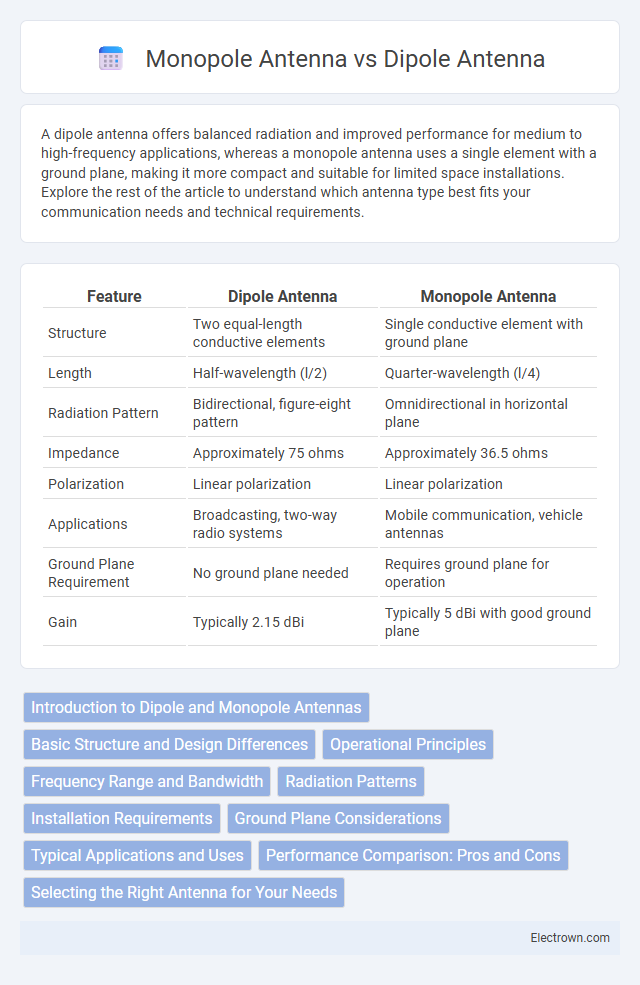A dipole antenna offers balanced radiation and improved performance for medium to high-frequency applications, whereas a monopole antenna uses a single element with a ground plane, making it more compact and suitable for limited space installations. Explore the rest of the article to understand which antenna type best fits your communication needs and technical requirements.
Table of Comparison
| Feature | Dipole Antenna | Monopole Antenna |
|---|---|---|
| Structure | Two equal-length conductive elements | Single conductive element with ground plane |
| Length | Half-wavelength (l/2) | Quarter-wavelength (l/4) |
| Radiation Pattern | Bidirectional, figure-eight pattern | Omnidirectional in horizontal plane |
| Impedance | Approximately 75 ohms | Approximately 36.5 ohms |
| Polarization | Linear polarization | Linear polarization |
| Applications | Broadcasting, two-way radio systems | Mobile communication, vehicle antennas |
| Ground Plane Requirement | No ground plane needed | Requires ground plane for operation |
| Gain | Typically 2.15 dBi | Typically 5 dBi with good ground plane |
Introduction to Dipole and Monopole Antennas
Dipole antennas consist of two conductive elements arranged symmetrically with a feed point at the center, typically offering omnidirectional radiation patterns in the horizontal plane. Monopole antennas function as a single conductive element mounted perpendicular to a ground plane, utilizing the ground as a reflective surface to create an image antenna and effectively doubling the antenna length. Both antenna types are fundamental in wireless communication, with dipoles often used in balanced feed systems, while monopoles are favored for compact installations requiring a simpler ground reference.
Basic Structure and Design Differences
Dipole antennas consist of two conductive elements usually of equal length, oriented in a straight line, creating a balanced structure that radiates electromagnetic waves symmetrically. Monopole antennas feature a single conductive element mounted perpendicularly above a conductive ground plane, effectively acting as one half of a dipole antenna and requiring less physical space. The dipole's design offers bidirectional radiation patterns, while the monopole antenna provides an omnidirectional pattern primarily in the horizontal plane, optimizing different applications based on space and coverage requirements.
Operational Principles
Dipole antennas operate by using two conductive elements with equal length, fed at the center to create a balanced radiation pattern through symmetrical current distribution. Monopole antennas utilize a single conductive element mounted above a conductive ground plane, effectively forming a quarter-wavelength radiator with an image current in the ground plane that results in an omnidirectional radiation pattern. The operational difference influences impedance matching and radiation efficiency, where dipoles typically exhibit a feedpoint impedance around 73 ohms, while monopoles present approximately 36.5 ohms due to ground plane effects.
Frequency Range and Bandwidth
Dipole antennas typically operate efficiently across a wider frequency range and offer broader bandwidth compared to monopole antennas, making them suitable for diverse communication applications. Monopole antennas, often requiring a ground plane, generally have narrower bandwidth and function well in lower frequency ranges but can be optimized for specific bands. Your choice between dipole and monopole antennas should consider the desired frequency range and bandwidth to ensure optimal performance for your wireless systems.
Radiation Patterns
Dipole antennas exhibit a figure-eight radiation pattern with maximum radiation perpendicular to the antenna axis, providing balanced two-way transmission suitable for many applications. Monopole antennas, being essentially a dipole over a ground plane, produce an omnidirectional radiation pattern in the horizontal plane, ideal for broad coverage. Understanding these radiation patterns helps optimize Your antenna choice based on the desired signal direction and coverage area.
Installation Requirements
Dipole antennas require a balanced feedline and clear space for two equal-length conductive elements, often mounted horizontally or in an inverted V shape, necessitating support structures at both ends. Monopole antennas need a single vertical element and a ground plane, which can be a metal surface or a radial system, simplifying installation by requiring fewer mounting points and less space. Your choice depends on the available installation area and whether you can provide an adequate ground plane or balanced feed system.
Ground Plane Considerations
Dipole antennas require no external ground plane as their two-element structure inherently provides balance, whereas monopole antennas depend critically on a conductive ground plane to function effectively by acting as a mirror for the radiating element. The size and conductivity of the ground plane directly influence the radiation pattern, impedance, and efficiency of a monopole antenna, making its proper design essential for optimal performance. Understanding these ground plane considerations helps ensure your antenna system achieves the desired signal strength and coverage.
Typical Applications and Uses
Dipole antennas are commonly used in radio and television broadcasting, wireless communication systems, and HF and VHF frequency bands due to their balanced design and omnidirectional radiation pattern. Monopole antennas are typically employed in mobile communications, GPS devices, and AM radio receivers because of their simpler construction and effective vertical polarization over ground planes. Understanding your application's frequency range and installation environment helps determine whether a dipole or monopole antenna will optimize signal strength and performance.
Performance Comparison: Pros and Cons
Dipole antennas offer balanced radiation patterns and typically provide better signal stability and range compared to monopole antennas, which are simpler and require a ground plane for operation. Monopole antennas excel in ease of installation and compact design but may suffer from reduced bandwidth and performance in environments with poor grounding. Your choice should consider the specific application, balancing the dipole's superior signal quality against the monopole's practical deployment advantages.
Selecting the Right Antenna for Your Needs
Choosing between a dipole antenna and a monopole antenna depends on your space constraints, frequency range, and installation preferences. Dipole antennas typically offer better balanced radiation patterns and are ideal for center-fed configurations, while monopole antennas are more compact and require a ground plane, making them suitable for restricted spaces. Your decision should factor in the desired coverage area and the environment where the antenna will operate.
Dipole Antenna vs Monopole Antenna Infographic

 electrown.com
electrown.com